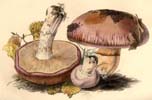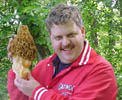Charles Edwin Bessey (1845 - 1915)
Back to Author Index
Biography
Sources
Home Page
Selected publications
Biography
1845 May 21, born in a log cabin in Wayne County, Ohio
1866 enters Michigan Agricultural College with the intention of majoring in civil engineering
1869 graduates from college after majoring in botany, receives assistantship in horticulture to work in the college greenhouse, but leaves soon after to become instructor in botany and horticulture at Iowa College of Agriculture, where he eventually becomes a full professor
1872 meets Dr. Asa Gray, visits him at Harvard periodically for further training (where meets wife?)
1873 marries Lucy Athearn of Martha's Vineyard
1884 appointed professor of botany at University of Nebraska
This Bessey (the other one was his son) was mainly an educator who did much to raise the standards of teaching botany in this country. He wrote textbooks that were widely used, and his teaching of botany as a lab class, requiring the use of the microscope, did much to make this a standard method of instruction.
His home page, at the University of Nebraska website listed below, says
Under Bessey's leadership, which lasted until his death in 1915, Nebraska developed an extraordinary program in botany. For this period, the University of Nebraska ranks among the top five schools in the number of its undergraduates in botany who received starred notations in American Men of Science.
Although Bessey is mainly here because of his training of others (his first graduate student was Joseph Charles Arthur, for example, but mostly he worked with phanerogams), one of his own contributions may have had an indirect effect on mycology: the conventional wisdom of his time was that reduced, non-showy flowers of trees and grasses were primitive forms, from which the more complicated and showy flowers evolved. This was in line with the conventional 19th century additude that evolution always proceeded in a direction from things that we find uninteresting towards things that we would like to have in our gardens (see, for instance, Karl Nägeli). Bessey's 1915 work, besides being the ur-source for phylogenetic taxonomy, disputed this prejudice, and "asserted that the plants with bisexual flowers with numerous petals, sepals, etc., were the basic types from which the reduced kind, for example willows, oaks, and birches, representing several unrelated but superficially similar lines, were derived." (Isely) Mycologists have had (and sometimes still have) to make similar arguments concerning fungi that lack sexual reproduction.
Back to top
Sources
Duane Isley (1994) One Hundred and One Botanists
Harry Baker Humphrey (1961) Makers of North American Botany
Back to top
Home Page
Charles Edwin Bessey
Selected Publications
Charles Edwin Bessey (1880) Botany for High Schools and Colleges
Charles Edwin Bessey (1884) "An enormous puff-ball" in American Naturalist 18:5 p. 530This publication established the official record for a puffball: 1.6 meters long, 1.35 meters wide, and about 24 cm high. According to the little calculator on my desktop, that's 5 feet four inches by 4 feet six inches, by 10 inches high.
Charles Edwin Bessey (1884) The Essentials of BotanyThis went through seven editions, the last one in 1896
Charles Edwin Bessey (1894) "The homologies of the Uredineae (The Rusts)" in American Naturalist 28:336 pp. 989 - 996
Charles Edwin Bessey (1907) "A synopsis of plant phyla" in University of Nebraska Studies 7:4 pp. 1 - 99
Charles Edwin Bessey & Ernst Athearn Bessey (1914) Essentials of College Botany
Charles Edwin Bessey (1914) "A Notable Botanical Carreer" in Science N. series 40 p. 48
Charles Edwin Bessey (1915) The Phylogenetic Taxonomy of Flowering PlantsThis book is the first phylogenetic classification system in botany, and the model for others that really started to catch on in the 1950's and 60's.
Back to top











